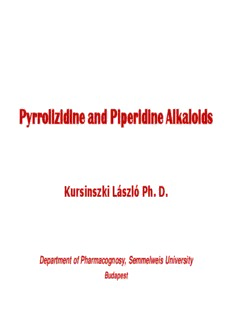
Pyrrolizidine and Piperidine Alkaloids - Semmelweis University PDF
Preview Pyrrolizidine and Piperidine Alkaloids - Semmelweis University
Pyrrolizidine and Piperidine Alkaloids Kursinszki László Ph. D. Department of Pharmacognosy, Semmelweis University Budapest Pyrrolizidine Alkaloids Pyrrolizidine alkaloids Occurence • In 288 species, 40 genera, about 60 medicinal plants (WHO, 1988). • Asteraceae, Boraginaceae, Fabaceae, Apocynaceae, Euforbiaceae, Poaceae, Ranunculaceae, Scrofulariaceae General structure of the alkaloids Vast majority of these alkaloids are esters of aminoalcohols and of one or two aliphatic carboxylic acids. Pyrrolizidine alkaloids Aminoalcohols (necins): • They are derivatives of pyrrolizidine. • The configuration at C8 varies, and is most often H-8α. • The ring is not always unsaturated at C-1, but it is always substituted by a hydroxymethyl group at this position. • A second hydroxyl group is possible at C-7, and in rare cases, a third hydroxyl group at C- 2, or at C-6. • In some cases, oxidation at C-8 leads to the opening of the bicyclic structure (otonecin). Pyrrolizidine alkaloids The acids (necic acids) are C5, C7, C8 or C10 aliphatic acids, • sometimes simple: angelic or tiglic acids with five carbon, • most often specific to this type of alkaloid: ‒ C7 hydroxyisopropylbutanoic monocarboxylic acids (lasiocarpic, trachelanthic, viridifloric acids) ‒ C8 dicarboxylic acids (monocrotalic acid) ‒ C10 dicarboxylic acids (senecic, jacobinecic, retronecic acids) Pyrrolizidine alkaloids Alkaloids: Mono- or diesters of monocarboxylic acids (caracteristic of the Boraginaceae): • C-9 OH is esterified by a hydroxyisopropylisobutanoic acid (lycopsamine, intermedine) • C-7 OH is esterified by either angelic or tiglic acid (in case of diesters only) Pyrrolizidine alkaloids Macrocyclic diesters (mainly in the Asteraceae): The pyrrolizidines that are 7,9-diols may be esterified by a dicarboxylic acid , which leads to a macrocycle (senecionine, symphitine). Biosynthesis of pyrrolizidine alkaloids 1 2 2 1 2 2 1 3 2 3 The NAD+ dependent condensation of two molecules of putrescine (or putrescine + spermidine) yields a symmetrical intermediate, namely homospermidine. The latter is subsequentl cyclized according to a classic sequence: 1, 2, 1, 3. Pyrrolizidine alkaloids Toxicity These alkaloids are cytostatics, some of them mutagenic and can cause hepatic tumors. A. for Animals: • Consumption of feedstuff contaminated by these toxic plants. Effective treatment do not exits. • The toxicity is chiefly hepatic: swelling of the hepatocytes, centrolobular necrosis, caryomegaly, thrombosis of the hepatic vein, increase in bilirubinaemia↑, and liver failure. • Symptoms depends on alkaloid structure, type of intoxication and the animal species. B. for Humans Mainly chronic intoxication. Eg.: consumption of grains contaminated by the seeds of Crotalaria retusa L. ( in Afghanistan, India in the seventies). Crotalaria retusa L. traditionally used for the flu or pulmonary ailments in the Antilles. Structure and toxicity: To be toxic the alkaloid must be dehydrogenated at C-1 and C-2, and at least monoesterified. Toxicity: Monoesters < acyclic diesters, < macrocyclic diesters. Pyrrolizidine alkaloids Pyrrole derivatives resulting from the microsomal oxidation of the pyrrolizidines in the liver, react as alkylating agents with biological nucleophiles such as nucleic and protein macromolecules.
Description: